How to Create an Estimate in QuickBooks?
The accounting software enables you to make estimates directly through its option. It can be possibly found in the +New menu. To create estimates in QuickBooks Online, the Estimates option can again be used via this menu. The users of QuickBooks Desktop can look at the Customers feature to find a way to make this document. In these methods, you can be asked to mention the correct values or dates relating to the product or service.
Method 1: Creating in QuickBooks
Creating an estimate in QB is an uncomplicated process. You can proceed with the method by launching the QuickBooks account. Next, you may select the +New tab. Now, start searching for the Estimate icon under the Customer’s banner. Then you are required to type the details and after that choose the name of your customer.
- Launch your “QuickBooks” account.
- Tap on the “+New” icon.
- You will find the “Estimate” option under the “Customers” title.

- Type in the details of the estimate.
- Select your customer’s name from the drop-down or enter the name in the prescribed box.
- In case no customer is added, go to the “+Add” option.
After filling in the name of the customer, press “+Details”.

- Once you have completed entering the details, hit “Save”.
- Tap on “+Add New” to enter the products and services.
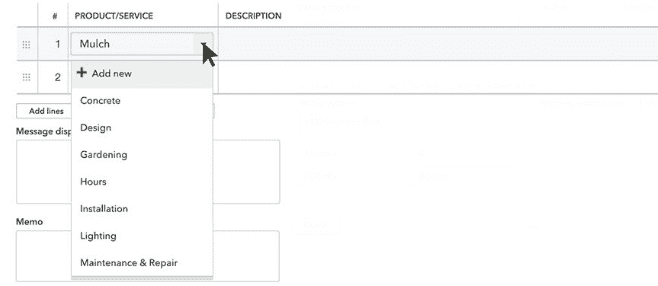
- Mark the “Income Account”.
- Select “Save and Close”.
- Fill up “Rate”, “Quantity”, and “Amount” for the product and service.

Under the “Settings” tab, opt for “Custom Form Styles”.

- At the top right, you will find the “New Style” drop-down.
- Choose “Estimate” from here.

In the “Design” field, change the name from “Estimate” to “Bid”.
Note: This step will customize the form style from “Estimate” to “Bid”.

- Now, move to the homepage and select “Invoicing”.
- Pick the “All Sales” tab.
- Next, press the “Estimate” button.

- Then click on the “Pending” tab at the top.
- Switch the status to “Accepted”.

Once completed, head to “Save and Close”.
Method 2: Preparing Estimate in QuickBooks Online
To create an estimate in QuickBooks Online, you need to go by the Estimate tab. Commence this method by signing in to your QBO account. Then head to the +New icon on the menu and move to Customers. After this, visit the tab suggested above. Further, opt for the Customer in the drop-down menu for whom you want to create the estimate. Also, look over the Estimate Date and Expiration Date.
- Sign in to “QuickBooks Online”.
- Click on “+New” from the menu.
- Go to “Customers”.
- Press the “Estimate” button.
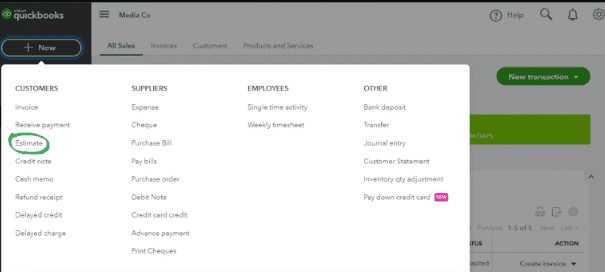
- Choose “Customer” from the drop-down menu.
- You may also check “Estimate Date” and “Expiration Date”.
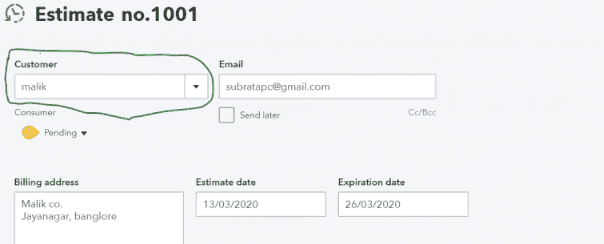
- Fill in the following fields:
- “Product/Service”
- “Description”
- “Qty”
- “Rate”
- “Amount”
- “Discount”
- “Tax”
- “Message”
- Tap on a drop-down named “Save and Send”.
- Then pick “Save and Close”.
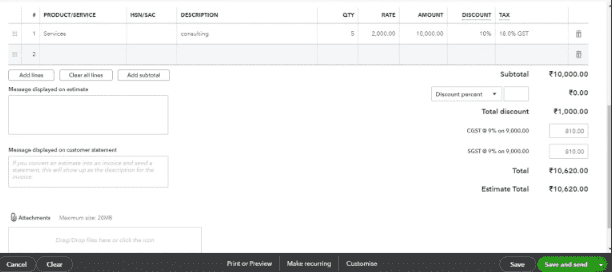
Method 3: Make Estimate in QuickBooks Desktop
An Estimate can be made in QuickBooks Desktop by using the Customers option. To begin, click on this option and then go to Estimates/Create Estimates. From the drop-down menu named Job, choose the Customer/Customer Job option to finally create an estimate in QuickBooks Desktop.
- Run “QuickBooks Desktop”.
- Select “Customers”.
- Click on “Estimates/Create Estimates”.
- You will find a drop-down titled “Job”.
- From here, pick “Customer/Customer Job”. “Add New” is to be selected if the option is not available on this drop-down.
- Enter the information for “Date” and “Estimate” in the displayed form.
- Then choose the items that are to be included in the sale.
- To create a discount item, move to the “Lists” option on the menu.
- Opt for “Item List”.
- Right-click on the screen anywhere.
- Hit “New”.
- A “New Item” page will open up.
- Make a choice of “Type” from the drop-down menu.
- Next, press “Continue”.
- Type “Item Name” or “Item Number”.
- Also, enter the “Description”.
- Fill in the discount percentage or amount in the field of “Amount or %”.
- Select the income account which is to be tracked for the discounts in the drop-down of “Account”.
- Pick the suitable “Tax Code”.
- After that, move to “Ok”.
- Tap on “Save & Close”.
Влияние estimated purchase date на поисковую оптимизацию
За счет использования estimated purchase date, поисковые системы могут отображать более актуальные результаты поиска, которые соответствуют временным ожиданиям пользователей, что значительно улучшает опыт поиска и удовлетворяет требованиям пользователей.
Оптимизация контента и ключевых слов с учетом estimated purchase date может улучшить видимость вашего сайта в результатах поиска, особенно если у вас есть информация о планируемых покупках пользователей.
Для оптимизации под estimated purchase date рекомендуется использовать ключевые слова, связанные с конкретными продуктами или услугами, а также фразы, отражающие ожидаемую дату покупки. Например, если вы продаете электронику и имеете информацию о том, что пользователи планируют покупку перед новым годом, вы можете использовать фразу «подарки на Новый год» или «новая электроника для праздников» для оптимизации контента и мета-тегов на вашем сайте.
Кроме того, рекомендуется учитывать сезонность и популярные события при оптимизации контента
Например, если вы продаете товары для пляжного отдыха, вы можете учесть estimated purchase date и использовать фразы, связанные с летним сезоном или праздниками, чтобы привлечь внимание пользователей
Помимо оптимизации контента, важно также улучшить пользовательский опыт на вашем сайте. Используйте ясную и удобную навигацию, ускорьте время загрузки страницы, создайте удобную структуру сайта, чтобы помочь пользователям легко найти и приобрести нужные товары или услуги
В целом, использование estimated purchase date для поисковой оптимизации позволяет предоставить пользователям более актуальные результаты поиска и улучшить их опыт. Оптимизация контента и улучшение пользовательского опыта могут помочь вам привлечь больше целевых посетителей и увеличить конверсию покупок.
Использование даты ожидаемой покупки в бизнесе
Дата ожидаемой покупки (estimated purchase date) – это важный показатель для бизнеса, который позволяет спрогнозировать объемы продаж и составить планы на будущее. Эта дата определяет, когда покупатель планирует совершить покупку, что позволяет компании вовремя подготовиться и обеспечить товары или услуги в нужном количестве и в нужное время.
Ведение базы данных с датами ожидаемой покупки позволяет бизнесу контролировать потоки клиентов и распределять ресурсы в соответствии с планами покупателей. Это позволяет снизить риски связанные с недостаточным количеством товаров на складе или чрезмерной нагрузкой на персонал в периоды спроса.
Для эффективного использования даты ожидаемой покупки необходимо уметь анализировать и прогнозировать данные. Бизнес должен следить за изменениями мнения клиентов и рынка в целом, чтобы корректировать свои стратегии в соответствии с новыми трендами
Кроме того, важно уметь оперативно реагировать на изменения потребностей клиентов и адаптировать производство или услуги к новым требованиям
Данные о дате ожидаемой покупки должны быть надежными и актуальными, чтобы бизнес мог положиться на эти данные при планировании производства и порядке закупок товаров.
Нужно уметь правильно интерпретировать данные о дате ожидаемой покупки, чтобы лучше понимать спрос и планировать объемы производства.
Важно учитывать специфику бизнеса при анализе и использовании данных о дате ожидаемой покупки. Например, для розничной торговли важно знать о датах ожидаемых покупок в периоды особых распродаж, а для производственных предприятий — важно знать, какие товары и услуги пользуются наибольшим спросом.
The Competitive Advantage of Offering Estimated Delivery Dates
Providing accurate and reliable estimated delivery dates can be a significant competitive advantage for eCommerce businesses.
By meeting customer expectations and delivering products within the estimated timeframe, businesses can increase customer satisfaction, build a reputation for reliability, reduce cart abandonment rates, and improve their supply chain management.
In addition, offering faster or more reliable delivery options than competitors can help increase sales and market share.
In today’s competitive eCommerce landscape, businesses that can provide accurate and reliable estimated delivery dates are better positioned to meet customer expectations and gain a competitive edge over their competitors.
ShipperHQ Solutions
If you’re a retailer ready to improve your shipping experience and margins, it’s time for a new partner. With ShipperHQ’s powerful Shipping Rate Management Platform, you’ll gain access to key features that will improve customer satisfaction – and conversions.
Features like , which lets you ship items from the closest location to the customer; , which lets customers choose an exact date and time for their delivery; and , which gives you complete control of your shipping strategy at checkout. If you are on Magento 2, you can even go a step further with our Enhanced Checkout solution to access comprehensive order details at a glance and an Amazon-style split shipping experience.
ETA meaning
«What’s the ETA on that?»…..Let’s face it none of us especially like waiting for things. But knowing how long we can expect to wait can make the experience a whole lot better.
That’s why communicating your plans to your paying customers is critical to the success of your business. By accurately estimating your arrival or delivery time, you can give your business, your employees, and your customers an easier life and a better experience. Delivery route planning, in fact, is built on being able to accurately predict and communicate ETDs to customers.
We take you through the in’s and out’s of ETAs and ETDs below and provide useful hints and tips to get your own solution in place.
Зачем берется банковская ставка
Снова приведем пример
Костя выиграл в лотерею. После уплаты налогов у него остался 1 миллион рублей. Костя решил открыть свой бизнес – небольшое кафе. Арендовал помещение, купил оборудование, нанял персонал, сам за всем следил, практически в своем кафе поселился… Через год получил первую чистую прибыль – 50 тысяч рублей.
В то время как на момент открытия кафе можно было положить деньги в банк на депозит по 6% годовых. И получить по окончании года доход в 60 тысяч рублей, миллион обратно в свое распоряжение и все это не особо напрягаясь и с минимальными рисками.
С этим примером мы вплотную подошли к тому, для кого в идеале делается бухгалтерская отчетность по МСФО. А делается она для потенциальных инвесторов, которые, посмотрев на нее, должны принять решение: вложить свои деньги в эту компанию или проще отнести их в банк на депозит?
То есть инвестор, анализируя состояние дел компании по отчетности, подготовленной по принципам МСФО, оценивает выбор между двумя инвестиционными проектами – с компанией и с банком.
А, поскольку, в бухотчетности мы отражаем то, что есть именно на текущий момент, то для информативного отражения, например, расчетов по аренде и лизингу, мы пользуемся вторым способом, позволяющим сравнить разные проекты – дисконтированием. И из этих же соображений часто подставляем в формулу ставку дисконтирования – величину банковского процента.
Наиболее популярные функции и формулы в Google Студии Данных
Округление (ROUND)
Позволяет превратить цифру с длинным хвостом в нужную. Например, превращение показателя отказов в целое число.

Вводим нужную конструкцию, где 0 отвечает за отображение целого числа. Также имеется умножение на 100, так как показатель отказов в Google Analytics — это число от 0 до 1.
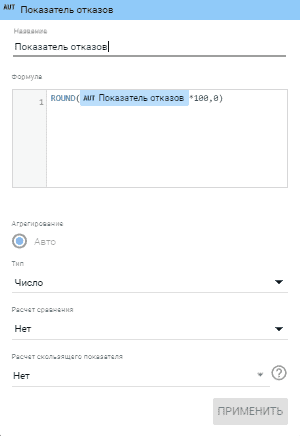
Задача выполнена.

CASE и END
Дает возможность использовать конструкцию ЕСЛИ, например, если канал трафика в Google Analytics organic представим его аналогично Яндекс.Метрике как поисковый трафик. Для этого создаем новый показатель.

Вводим нужную конструкцию.
case
when канал=’organic’ then ‘Поисковый трафик ‘
end
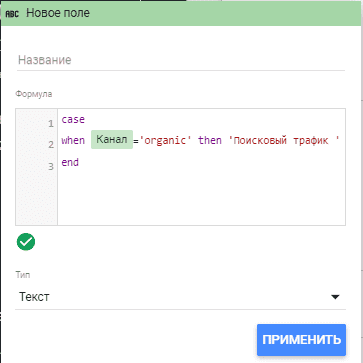
Готово.

Регулярные выражения (REGEXP_MATCH и REGEXP_EXTRACT)
Позволяют использовать регулярные выражения аналогично Google Analytics и Яндекс.Метрике в дашбордах Data Studio.
Например, из примера выше, можно сделать замену органики и рефералов на «Органический трафик» (Лишь для примера). Применяем в этом случае:
case
when REGEXP_MATCH(Канал,’^(organic|referral)$’) then ‘Органический трафик’
end
Получаем готовый вариант.
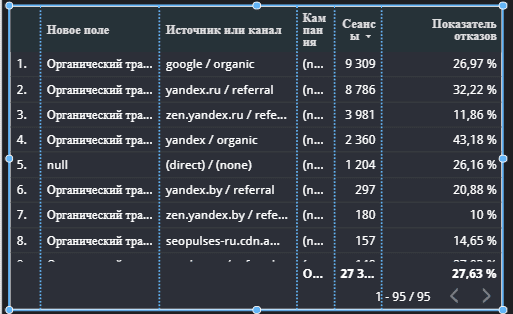
Подписывайтесь на наш Telegram-канал
Подписывайтесь на наш Youtube-канал
Подписывайтесь на нашу группу ВКонтакте
Understanding Purchase Order Lead Times (POLTs)
The purchase order lead time is how long it takes for an order to be fulfilled—from the time the order is placed until the estimated date of receipt. So if a company places an order for supplies on May 1 and it’s expected to be delivered on May 10, the POLT for the supplies is nine days. This timeframe is heavily influenced by a number of factors, including the types of goods required by the company, the availability of materials, where they come from, the location of the suppliers, and even the time of year.
The POLT includes a number of different steps, including the:
- Confirmation of the order
- Availability of the goods
- Order placement
- Acknowledgment of the order
- Shipping notice
- Receipt of the goods
- Invoicing
- Payment
Companies must carefully plan purchase order lead times when planning a manufacturing run because if production inputs do not arrive on schedule, manufacturing will be delayed, costing the company money in lost sales, idle worker time, and lower factory overhead absorption. On the other hand, if inputs arrive too early, the company could incur additional inventory storage costs.
For this reason, managers need to plan as precisely as possible when they need to order the materials needed, lest they incur additional overhead. If they have a trusted supply chain, this should be one of the first items added to a production and/or staffing calendar.
There are ways companies can reduce the number of days in a POLT:
- Increasing the number of orders. This is a better option compared to putting in one or two large orders. By doing so, companies can save both time and money. This can also ensure they don’t have too much of a certain supply while maintaining enough stock to keep fulfilling orders.
- Changing suppliers. Using local or domestic suppliers over international ones may help cut down on lead times, which, again, can save time and money.
- Automating the order process. By moving to a system that automatically places and fulfills orders, companies can free up manpower for other tasks, and personnel can have more time to do their jobs. Automation also helps cut back on any possibility of error when it comes to the order placement process.
Manufacturers must be aware of the possibility of a delay if inputs are ordered from a faraway location.
What is estimated time of arrival [ETA] and why does it matter?
When we talk about estimated time of arrival, we refer to the time and date that a shipment is expected to arrive at a particular destination. Although the specific location can vary from case to case, it is generally a seaport or airport. However, the most common place you will hear an ETA referred to is when a passenger plane is expected to land at an airport.
This is the easiest way to remember that ETA refers to the airports and seaports. In the vast majority of cases, the shipping method will be via air, sea or domestic shipping services such as rail or road.
SmartRoutes Route Planning Software
Streamline your entire delivery process, all from one platform

Create a Purchase Order from an Estimate in QuickBooks Online by Copying
It is possible to create a purchase order in QBO provided that you copy it from an Estimate. For doing so, you have to switch on the Purchase Order feature and then create it through the way suggested. Before this, go to the Settings option on the menu in the software. Then hit the Account and Settings button. Next, search for the Expenses tab and then continue to create a purchase order from the estimate in QuickBooks Online.
- Visit “QBO” and click on the “Settings” menu.
- Tap on “Account and Settings”.
- Press the “Expenses” button.
- Once done, find the section of “Purchase Order”.
- Choose the icon that looks like a pencil.
- Next, pick “Use Purchase Orders”.
- Hit the “Save” tab. This will switch on the feature for “Purchase Order”.
Now, to create the estimate by copying it, continue with the steps below:
- Click on “+New”.
- Select the “Estimate” option.
- Type the “Service” details or the “Customer” and “Product” details.
- Hit “Save”.
- Opt among these drop-down options:
- “Create Invoice”
- “Copy to Purchase Order”
- Then go for “Copy to Purchase Order”.
- Pick a “Vendor”.
- You need to choose the customer that you have used for the purchase order from the section of “Item Details”.
- Choose “Save and Close”.
Once it gets copied, the purchase order will be ready in QuickBooks Online. By using more estimates, other purchase orders can also be formed.
Conclusion
Creating an estimate in QB can be of use for a company as well as its customers. The post defined in-depth the usage of an estimate. Also, it marked the steps for the creation of an estimate in the software and its other versions. Further, various methods to create an invoice from an estimate as well as a purchase order were shared for your knowledge.
Also, go through our other blog to come across the ways.
- import your bank transactions into QuickBooks.
- IIF export on Windows and Mac
Setting Up Estimated Delivery Date
The first thing and most important thing to know — Estimated Delivery Date is available for all plans.
The second thing — the feature works for all shipping methods except for local delivery and pickups. Just because these methods are usually made in a few next days, and let the customers set up the date.
Action!
When you , you’ll find a list of shipping options. Choose any carrier to edit and see this small yet essential setting — Show estimated delivery date at checkout.

Enable delivery date settings on the Shipping & Pickup page in the Ecwid admin panel
By enabling this feature, you will activate the following settings:
- Order preparation time — how long it takes to get the order ready for shipping (for you to produce, assemble, and/or pack your item).
- Days you pack orders — if your online store is a side business, and you only process orders on weekends, you’ll be able to indicate that to make delivery date estimates are precise. On the other hand, if you’re a full-time online merchant and take the weekends off, you can also let the system know to ensure accurate delivery dates.
- I pack orders received past this time on the next day (a.k.a. order-processingcut-off time) — you don’t have to package new orders day and night. You can mark a cut-off time for packing orders automatically, so the system knows that orders placed after a certain time will be processed the next day. This lag becomes calculated in the delivery date estimation. If the next day is your off day, the system will take this into account as well.

Describe your fulfillment process to let your customers breathe while waiting for their delivery
All these settings influence the date displayed at checkout.
By making your order processing more transparent, you can help shoppers choose the right shipping option for them, even if it’s more expensive. Knowing when to expect their purchase will save the customers from order frustration, and save you from their potential anxiety.
There’s one more important setting — Approximate transit time. It’s used to define how many days it takes to deliver the order from the carrier’s office to the customer’s location.
If you ship with USPS, UPS, FedEx, Canada Post, MDS, or Brasil Correios and use carrier-calculated automatic rates your Ecwid shop will receive transit times automatically and add them to the overall delivery calculation. You won’t even see this configuration in action.
But if you ship with another carrier, or set up the shipping options manually, you’ll have to define transit time manually. It’s easy. Just set the minimum and the maximum number of days the delivery will take. Ask your shipping company to help you with transit estimates. Consider adding an extra day to the transit time to play safe, just in case.

Be careful with the dates, don’t create expectations that you won’t be able to fulfill
Still have questions? Here’s a full-fledged video tutorial on setting up carrier calculated shipping with the Estimated Delivery Date feature.
When would You Create an Estimate in QuickBooks?
An estimate works as a bid that is offered to a customer which contains the details of products and services provided by a company. Additionally, the cost at which it will be selling those items is also included. Thus, it acts as a tool for marketing that helps the customers in deciding whether they want to buy a company’s products/services or not. This is one reason to make an estimate in the software. Some other points to create an estimate in QuickBooks are as follows:
- Estimates can turn into invoices in the software.
- They act as a written agreement.
- Estimates can be compared to an actual income and cost by running reports in QB.
What Benefits Do Customers have from Displaying the Estimated Delivery Date?
Customers can benefit from a definite delivery date when they require vital items delivered to their doorstep, like medicines. Having a rough idea of how much time it might take to provide a package will help customers plan when to place an order before they run out of a product.
If the customer has plans to be out during weekends or has a business trip coming up, he can plan accordingly when to place the order so that he is at home when it is delivered. This will be possible only if there is a delivery date given.
Customers can also select the best online retailer based on their delivery estimates and whether they deliver products within that time frame. Meeting delivery deadlines shows whether a company values its customers.
Customers can thus decide which companies are deserving of their time and money and which ones can go for a pass, based on whether they deliver products on time.
What to take into account when estimating delivering times
In a perfect world, packages would be delivered with 100% order accuracy. However, ecommerce shipping can be very complicated, and delays can and will happen for a variety of reasons.
Transit times and shipping services
Transit times differ based on the carrier you’re shipping with, the service chosen, the shipping destination, among other factors. Cheaper, slower delivery options are typically not guaranteed and may take several modes of transportation (such as cargo or air to truck), making the journey long and prone to varying conditions.
Generally, the farther the delivery, the longer it will take. If you’re willing to pay for it, fast and guaranteed options like overnight shipping can help ensure the ship date and delivery date.
Federal holidays
Holidays can significantly slow down the pace of shipping times due to many companies taking off on those days. If you’re shipping abroad, the sender or receiver may not be aware of the other country’s federal holiday closures.
In the US, many companies wouldn’t be open on:
- New Year’s Day (January 1)
- Martin Luther King Jr. Day (January 15)
- Memorial Day (the last Monday in May)
- Independence Day (July 4)
- Labor Day (the first Monday of September)
- Thanksgiving Day (the fourth Thursday in November)
- Christmas Day (December 25)
If you work with a fulfilment and shipping partner like ShipBob, you’ll need to check their holiday schedule, as that may also affect the timing of your shipments. You can find ShipBob’s Holiday Schedule and building closure schedule here.
Weather-impacted slowdowns
Natural slowdowns like heavy rains, snow, and damage from natural disasters could slow down your package deliveries. For example, when shipping to the Southern United States, it’s not uncommon to experience delays during hurricane season.
Customs
If you’re shipping internationally, there are even more variables that affect the shipping speed – the most significant being customs.
Customs can take days or even weeks to be cleared, so packages often get held up at customs longer than expected – especially if they lack the proper paperwork. Brands may need to present a variety of documents at customs, including (but not limited to):
- Proforma invoice
- Commercial invoice
- Export packing list
- Certificates of origin
- Certificate of free sale
- Shipper’s letter of instruction
- Inland bill of lading
- Ocean bill of lading
- Air waybill
- Letter of credit
If any of the necessary documents are not included, a shipment may be held up until they are obtained. This can delay your shipment and push your delivery date farther out.
Как использовать формулу в Google Data Studio
В датасете
Для этого понадобится в режиме редактирования перейти во вкладку «Ресурс»-«Добавленные источники данных».

Выбираем нужный коннектор (источник данных) и нажимаем на «Изменить».

Кликаем на добавить новое поле.

Теперь потребуется:
- Даем название значению;
- Вводим формулу.

Важно! Регистр (строчная или заглавная буквы) не влияет на работу функций. Важно! Прописывать текст можно, как и в языке Python, в одинарных кавычках ‘Текст1’, так и в двойных «Текст»
Важно! Прописывать текст можно, как и в языке Python, в одинарных кавычках ‘Текст1’, так и в двойных «Текст». Важно! Идентификатор поля заполнять не нужно, он выдается автоматически
Важно! Идентификатор поля заполнять не нужно, он выдается автоматически. Важно! При написании формулы в отличие от Excel и Google Таблиц не ставиться в начале знак «=»
Важно! При написании формулы в отличие от Excel и Google Таблиц не ставиться в начале знак «=». Во время написания формулы система будет показывать подсказки и выдавать значения из датасета
Во время написания формулы система будет показывать подсказки и выдавать значения из датасета.

Если формула заполнена некорректно, то в нижней-левой части интерфейса появится соответствующее уведомление.

Пример использования функций.

В отчете
После сохранения эти данные можно будет использовать в дашборде.
Важно! При использовании этого метода, потребуется создать дополнительный показатель в каждом отдельном элементе. В дашборде потребуется выбрать нужный элемент и кликнуть на «Создать поле»
В дашборде потребуется выбрать нужный элемент и кликнуть на «Создать поле».

После этого аналогично вышеописанной инструкции заполняем:
- Название;
- Описываем формулу.

Все готово метрика добавлена.
Which Factors Should be Considered While Calculating the Estimated Delivery Date?
The estimated delivery date depends on the following factors:
- Origin and Destination: The further away from the destination, the longer it takes to get the shipment to the customer’s doorstep.
- Route Condition: For instance, if an order needs to reach a tier 4 town from Mumbai, the estimated delivery date depends on the number of tolls and road conditions.
- Product Details: Large quantities take more time to deliver. Plus, inventory procurement from afar leads to delayed timelines.
- Average Transit Time: The transit duration for previous similar orders fulfilled by logistics companies should be calculated to get a better idea of the estimated delivery date.
- Estimated Shipping Date: Delivery depends on when the order gets shipped from the warehouse. Any delay there snowballs into delayed delivery to the end customer. It also means the ESD has an impact on the delivery date.
- Shipping Mode: Express and standard modes offer different delivery timelines. The option selected by the customer decides how fast the delivery will occur.
Год до даты: TotalYTD
Давайте начнем пример с простой функции для вычисления года до даты. Расчет года до даты — это совокупность значений с начала года до указанной даты. Например, значение продаж в годовом исчислении может быть суммой всех продаж с 1 января этого года до указанной даты. Специально для DAX существует функция DAX, которая называется TotalYTD. Вот функция TotalYTD:
TotalYTD( <expression>, <dates>, , )

Первые два параметра являются обязательными:
- Expression: выражение, которое применяет агрегацию значения
- dates: поле даты измерения даты.
В нашем примере мы вычисляем сумму поля SalesAmount в FactInternetSales. Таким образом, выражение будет следующим: Sum(FactInternetSales).
Для поля даты, так как мы используем измерение даты по умолчанию; при вводе имени поля даты (в данном случае OrderDate из FactInternetSales) у вас будет возможность выбрать поле из этой таблицы (помните, что поле даты является таблицей дат позади сцены, Power BI создает измерение даты по умолчанию для каждое поле даты) выберите поле .. Это подразумевает поле даты в таблице дат по умолчанию.
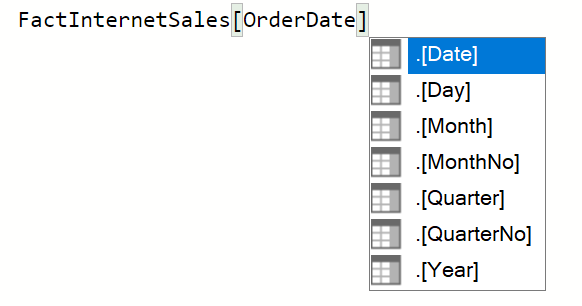
Таким образом, в результате вот выражение для расчета “год до даты”: (Обратите внимание, что это показатель, а не столбец)
|
1 2 3 4 |
Sales YTD = TOTALYTD( SUM(FactInternetSales), FactInternetSales. ) |

и пример вывода будет следующим:
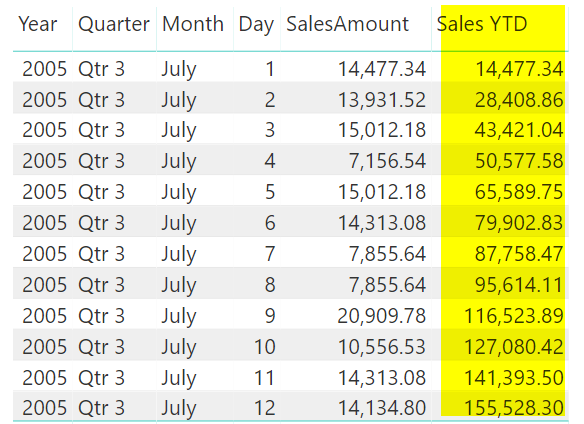
Как вы можете видеть, показатель Sales YTD представляет собой накопленные значения всех дат до начала года (для получения правильного результата вы должны иметь OrderDate в визуале, и его следует упорядочить по возрастанию OrderDate). На приведенном выше рисунке показан расчет по каждому дню, если мы удалим день из визуального элемента (вы можете удалить его из раздела «Fields» визуального элемента),
затем вы можете рассчитать год до даты на месячном уровне, как показано ниже:
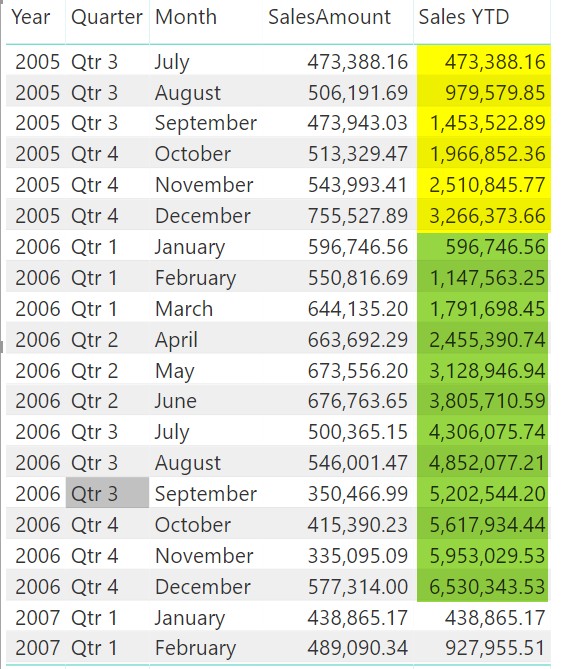
Как вы можете видеть на скриншоте выше, расчет “год до даты” за каждый месяц — это совокупный объем продаж за все месяцы до этого (с января того года).
How can companies provide a delivery date estimate?
Delivery estimates can improve the shopping experience and enable customers to make more informed decisions around when to order and which shipping option to choose. That’s why many forward-thinking brands choose to display delivery estimates on their product or checkout pages.
If you’re looking to implement delivery estimates, here’s how to get it right.
| Merchant action | Description |
|---|---|
| Have real-time stock monitoring | Keep your inventory, ecommerce, and order management systems are updated in real-time |
| Integrate with shipping carriers | Leverage carrier API integrations, or better yet use a solution like parcelLab which lets you display a «delivery date promise» |
| Establish shipping rules | Define shipping zones and understand the average delivery times to those zones |
| Factor in order processing time | Account for the time it takes to process an order—including picking, packing, and preparing the order for dispatch. |
| Leverage dynamic delivery calculation | Factor in current order volume, historical shipping times, and other variables |
| Provide a buffer | Account issues like an unexpected surge in orders, a delay at the shipping carrier’s hub, etc. |
| Regularly review and adjust | Gather and analyze data on actual delivery times versus estimates. |
| Use the right technology and software | Invest in a robust and tightly-integrated ecommerce tech stack that lets you implement delivery date estimates with ease |
Have real-time stock monitoring
Ensure that your inventory, ecommerce, and order management systems are updated in real-time as items are purchased or restocked. This helps in providing accurate estimates, especially if an item needs to be back-ordered.
Integrate with shipping carriers
Most major shipping carriers offer API integration, which can be incorporated into the ecommerce or post-purchase platform. This integration allows your system to get real-time shipping rates and delivery estimates based on the carrier’s data.
parcelLab’s Convert product suite, for example, enables you to display a delivery date promise on your product pages. Delivery estimates are more effective than simply displaying shipping speed (e.g. 3-7 days).
Establish shipping rules
You should also have a handle on your shipping methods. Different shipping methods (standard, expedited, overnight) have varying delivery times. Make sure the system knows the expected time for each method.
Factor in order processing time
Account for the time it takes to process an order. This includes picking, packing, and preparing the order for dispatch. Some companies can do this within hours, while others might take a day or two.
Leverage dynamic delivery calculation
Utilize algorithms that factor in current order volume, historical shipping times, and other variables to provide the most accurate delivery estimates.
If you’re using parcelLab, this is done automatically. We enable you to display unique dates for each carrier with a machine learning model and unique algorithm that accounts for delivery methods, carrier service levels, holidays, past performance, and trending data.
Provide a buffer
Always account for some margin of error. Whether it’s an unexpected surge in orders, a delay at the shipping carrier’s hub, or any other unforeseen hiccup, it’s wise to have a slight buffer.
Regularly review and adjust
Continuously gather and analyze data on actual delivery times versus estimates. Adjust the system’s parameters based on this feedback loop to improve accuracy.
Use the right technology and software
We’ve alluded to this earlier, but be sure to invest in an ecommerce tech stack or third-party solutions that specialize in dynamic delivery date estimation. Many of these tools come with advanced features that consider all the variables and help in providing customers with accurate delivery estimates.
And once an order is placed, you can further improve the post-purchase experience through proactive post-purchase communications. This can include order notifications, delivery updates, and more.
As always, when sending customer communications, always adhere to regulations like GDPR and follow the guidelines of the Federal Trade Commission.
What are the advantages of providing consignees/customers with ETD’s?
Great customer service
That ‘delivery experience’ we just mentioned is the key for businesses wanting to make a success of their delivery service. Without happy customers, a businesses long-term outlook will not be a good one
Getting customers excited about the arrival of their purchase and delivering it as promised leaves them satisfied and more likely to become a repeat customer and refer you to a friend.
Giving them an ETD in advance shows that you care about their time.
Smooth and efficient operation of your business
Giving your customer a forecast of when their order will arrive is actually as important to you as it is to them.
By providing consignees with accurate ETD in advance, it gives them a chance to make themselves available to receive the goods. This means that deliveries aren’t missed, drivers don’t waste time waiting around for someone that isn’t there, and you save on the cost of re-routing the delivery on another run.
This results in happier drivers and customers too, which eliminates time spent dealing with issues that shouldn’t exist.
How do Businesses and their Customers Benefit from Estimated Delivery Dates?
Estimated delivery dates are beneficial for both businesses and their customers in several ways:
- Managing customer expectations: Providing estimated delivery dates helps manage customer expectations and reduces the likelihood of customer complaints or frustration due to delayed delivery.
- Increased customer satisfaction: When a business can deliver products within the estimated delivery date, it can lead to increased customer satisfaction and loyalty.
- Increased sales: Providing estimated delivery dates can help increase sales by reducing the perceived risk of online shopping, making customers more likely to purchase.
- Reduced customer service workload: Providing estimated delivery dates can reduce the number of inquiries and complaints about delivery times, allowing customer service teams to focus on other issues.
- Better inventory management: Providing estimated delivery dates can help businesses better manage their inventory levels and ensure that they have sufficient stock on hand to fulfill orders within the estimated delivery time.
- Improved logistics and operations: Providing estimated delivery dates can help businesses optimize their logistics and operations processes to ensure that products are delivered within the estimated timeframe.
























![Codecanyon bwd product estimated shipping date v1.0.0 [47990580] - плагин рассчета даты доставки для woocommerce](http://sarfruits.ru/wp-content/uploads/5/2/4/52451d6a938b16c903cd5c31f6023500.webp)


